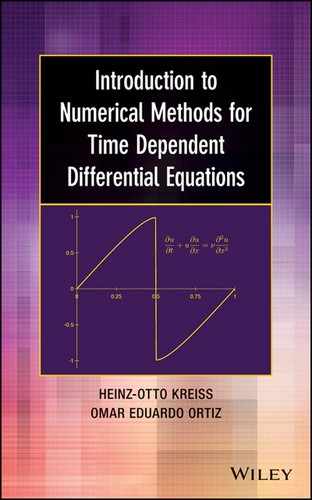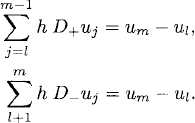CHAPTER 10
LINEAR INITIAL BOUNDARY VALUE PROBLEMS
The purpose of this chapter is to introduce the basic ideas of initial boundary value problems for partial differential equations and their finite difference approximations. We study the model equations of Chapter 9. Energy estimates, the simplest technique to use to study well posedness for these problems, is discussed first. Then the method of lines and the energy estimates for typical semidiscrete approximations are discussed.
10.1 Well-Posed Initial Boundary Value Problems
Fourier mode analysis is not easily generalizable to problems with boundary conditions other than periodic, whereas the construction of energy estimates presents no problem. Energy estimates are thus the classical way to study well posedness of initial boundary value problems.
10.1.1 Heat equation on a strip
Here we study the initial value problem for the heat equation on a strip:
with either fixed Dirichlet boundary conditions, u(0, t) = U0, u(1, t) = U1, or homogeneous Neuman boundary conditions, ∂u(0, t)/∂x = ∂u(1, t)/∂x = 0. In the first case it is convenient to redefine the solution u(x, t) by subtracting the linear solution U0 + x(U1 − U0) from it. Then the new function satisfies the same equation but with homogeneous boundary conditions. Therefore, it is sufficient to consider problem (10.1) with either
or
Smoothness of the solution. We give an example. We want to solve (10.1), (10.2) with initial data function

This initial data function is only continuous and the differential equation is not satisfied at the corners of the domain x = 0, t = 0 and x = 1, t = 0.
If we make an odd extension of f, that is,

we can calculate the exact solution of the original problem as if it were a periodic problem for x ![]() [-1, 1] using real Fourier series, as we studied before. Thus,
[-1, 1] using real Fourier series, as we studied before. Thus,

and the solution is
For t > 0 the Fourier coefficients in (10.4) decay exponentially fast with n; therefore the solution is C∞ smooth for 0 ≤ x ≤ 1 and t > 0 even when the data were only continuous. This smoothness property generalizes to other boundary conditions and other strongly parabolic equations. Further details are provided elsewhere [7].
Energy estimate. We define the energy of the solution of the initial boundary value problem (10.1) and (10.2) or (10.3) by
(10.5) ![]()
In physical applications u(x, t) generally represents a real variable such as temperature. However, the theory can be developed for a complex u without adding any difficulty. As some of the identities we derive are useful in other problems, we treat the case of complex u(x, t).
Differentiating the energy and using the equation, we get
(10.6) 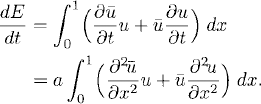
Integrating by parts, we get
(10.7) ![]()
Any of the boundary conditions (10.2) or (10.3) say that the first term on the right-hand side vanishes. The second term is nonpositive so that
(10.8) ![]()
We obtain
An immediate consequence of energy estimates is the uniqueness of the solution. If u1 and u2 are both solutions of the same initial boundary value problem (10.1) with (10.2) or (10.3), then by linearity the difference u(x, t) − u2(x, t) is also a solution of the same problem but with vanishing initial data. Then (10.9) implies that ||u1(·, t) − u2(·, t)||2 = 0; as the solutions are C∞ smooth, they are the same.
General parabolic problem. Consider the more general parabolic problem on the strip 0 ≤ x ≤ 1, t ≥ 0,
where a > 0 and b, c ![]()
![]() , with mixed boundary conditions
, with mixed boundary conditions
where r0 and r1 are real and f is assumed to be compatible with (10.11). In this case an energy estimate of the form
can be shown. The energy can grow exponentially, but at a rate that is independent of the initial data. We do not give a proof of this estimate here but refer the reader to reference [6].
10.1.2 One-way wave equation on a strip
We consider here the equation
with initial data
(10.14) ![]()
and Dirichlet boundary conditions
Smoothness and compatibility conditions. The smoothness of the solution of (10.13)–(10.15) depends on the smoothness of f(x), g0(t), and g1(t), and also on whether these functions match smoothly at the corners (0, 0) or (1,0) of the strip (i.e., the data functions satisfy the relation required by the equation at these corners).
For example, in the case a < 0, the data functions match smoothly up to second order at (0, 0) if
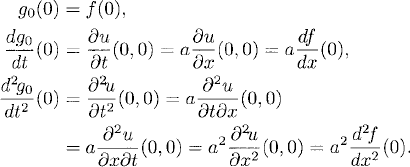
We give an example. We solve the problem (10.13)–(10.15) with a = 1 and

Here these two data functions are C∞ smooth. However, g1(t) and f(x) satisfy the equation at the right corner up to first derivatives but not to second derivatives. As a consequence, the solution

is C1 smooth and not C2 smooth for t ≥ 0.
For the solution to be C∞ smooth, the data functions have to match at all orders at the corners. The easiest way to achieve this is to choose C∞ smooth initial and boundary data functions so that f(x) has support on (ε, 1 − ε), 0 < ε ![]() 1, and gi(t), i = 0, 1 vanish if t ≤ ε. By a limit process, one can generalize this data to nonvanishing data at the corners and still get a C∞ smooth solution. Details on this procedure are available in reference [7].
1, and gi(t), i = 0, 1 vanish if t ≤ ε. By a limit process, one can generalize this data to nonvanishing data at the corners and still get a C∞ smooth solution. Details on this procedure are available in reference [7].
Energy estimates. Let
(10.16) ![]()
We have
Lemma 10.1 If u(x, t) solves problem (10.13)–(10.15), then
![]()
with i = 0 if a < 0 and i = 1 if a > 0.
Proof: Integration by parts gives us

Then, in either case, a < 0 or a > 0, we neglect the negative term and replace u by the boundary data function in the positive term, obtaining an inequality. Integrating the inequality between 0 and t, the lemma follows.
Now, assume that the solution of (10.13)–(10.15) exists and is C∞ smooth. One can differentiate the equation, initial data, and boundary condition as many times as one wants. For example, for a > 0,

Thus, all the derivatives satisfy the same equation as u with corresponding initial and boundary conditions. Therefore, one gets estimates for all the derivatives of u which are analogous to those for u itself. These are called a priori estimates. For example for ∂u/∂t, with a > 0, we have
![]()
In Section 10.2.4 we derive an energy estimate for a semidiscrete approximation of the problem (10.13)–(10.15). The existence and uniqueness of solution for the semidiscrete problem are not an issue. One can get estimates for all finite differences of the semidiscrete solution in analogy with the a priori estimates for the differential equation. These estimates can be obtained so that they are independent of the mesh size. Then one can prove that, in the limit when the mesh size goes to zero, the semidiscrete solution converges to a smooth function that is a solution of the differential equation. This is a way of showing the existence of solutions for the differential problem. Details on parabolic and hyperbolic equations are available in reference [7].
Exercise 10.1 Prove that the solution of (10.13)–(10.15) is unique.
10.1.3 Wave equation on a strip
In this section we study the wave equation by reducing it to a pair of one-way wave equations. Consider the initial value problem for the wave equation for φ(x, t):
Here c > 0 is the speed of propagation of the waves. If we consider the initial boundary value problem for 0 ≤ x ≤ 1, we need to prescribe boundary conditions. To get the correct boundary conditions, we reduce the equation to a first-order system. Defining
(10.18) 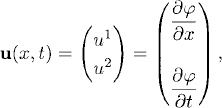
the wave equation reduces to the system
(10.19) ![]()
with
(10.20) 
The matrix A is diagonable. Calculating the transformation, we get
(10.21) 
Then, defining the variable
(10.22) 
we obtain a diagonal system for w:
with initial conditions
The equations for w1 and w2 are decoupled one-way wave equations.
We know that we need to prescribe boundary conditions for w1 at x = 1 and for w2 at x = 0. We also want to allow coupling of the left-traveling wave with the right-traveling wave. Then the boundary conditions we consider for system (10.23) are
where R1, R2 are constants, and ![]() are given functions, assumed to be compatible with the initial data.
are given functions, assumed to be compatible with the initial data.
We know that the problem is well posed if R1 = R2 = 0. To see whether there are restrictions on the values of R1, R2, we study the energy inequality. Let
![]()
Following the proof of Lemma 10.1 and using the boundary conditions (10.25), we have
(10.26) 
Therefore, if |R1|, |R2| ≤ √2/2, we have the energy estimate
(10.27) ![]()
The boundary conditions (10.25) can, of course, be written in terms of the original variables using S−1. We get
where ![]() . These conditions can be interpreted as the incoming wave prescribed in terms of the outgoing wave and a given function at each boundary.
. These conditions can be interpreted as the incoming wave prescribed in terms of the outgoing wave and a given function at each boundary.
10.2 Method of lines
In this section we study semidiscrete approximations for the model problems of Section 10.1. The differential initial boundary value problems will be reduced to systems of ordinary differential equations which can be written in matrix form. Thus, the methods we studied in the first part of the book can be used to integrate in time.
10.2.1 Heat equation
Dirichlet boundary conditions. Consider problem (10.1) with homogeneous Dirichlet boundary conditions (10.2). Let us call vj(t) the grid function that approximates u(xj, t) on the grid xj = hj, j = 0, 1, 2, …, N − 1, N. We approximate the differential problem by
As we studied in Chapter 9, D+D− is a second-order accurate approximation of the second derivative, and as the boundary conditions are exact, (10.29) is a second-order accurate approximation of the original problem.
The semidiscrete problem (10.29) is an initial value problem for a system of ODEs. It can be written in matrix form as
where

and
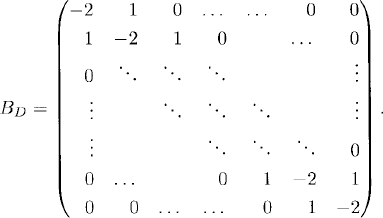
Notice that the boundary conditions v0(t) = vN(t) = 0 have been used for writing this matrix representation and then these two components are absent in v(t).
As BD is real and symmetric, the system of equations (10.30) is diagonable and we can apply the theory of Chapter 6. Moreover, we will show that the eigenvalues of BD are all negative and then system (10.30) is strongly stable as a system of ODEs.
Lemma 10.2 The matrix BD is diagonable; its eigenvalues λ are real and lie in the interval −4 ≤ λ < 0.
Proof: The matrix BD is real and symmetric and is therefore diagonable with real eigenvalues. We prove that all its eigenvalues are negative by showing that BD is negative definite. Let v be an arbitrary vector,
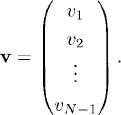
Then, if vt denotes the transpose of v,
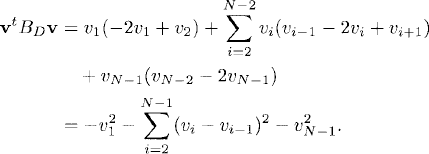
The last line is strictly negative unless v1 = 0 and vi = vi-1, i = 2, 3, …, N − 1 (i.e., unless v is the zero vector). Therefore, BD is negative definite, and all its eigenvalues are strictly negative.
We now prove that all eigenvalues of BD are bounded in absolute value. Let λ be any eigenvalue of BD and v one of its corresponding eigenvectors, which we assume to be normalized. Then, recalling Definition 6.1, we have

Therefore, all eigenvalues of BD lie in the interval −4 ≤ λ < 0.
Lemma 10.2 says that (10.29) [or its matrix version, (10.30)] is strongly stable as a system of ordinary differential equations. We can use the explicit methods that we studied in the first part of the book to integrate this system in time. The restriction on the time step k follows from Lemma 10.2. For example, if we use explicit Euler, we need to choose the time step small enough that −2 ≤ kλj ≤ 0 for all eigenvalues λj of aBD/h2. By Lemma 10.2, this means that
![]()
and then we need to choose k so that
(10.31) ![]()
This is the same stability condition (CFL condition) that we found in the periodic case. Other, higher-precision methods, such as Runge-Kutta methods, are of course preferred. If we use implicit Euler method to integrate (10.30), we obtain an unconditionally stable scheme.
Exercise 10.2 Write a computer code to compute the solution of (10.29) with a = 1 and initial data function

![]()
at the same times as those of item (a).
Homogeneous Neuman boundary conditions. Consider now problem (10.1) with homogeneous Neuman boundary conditions (10.3). To be able to write a second-order accurate semidiscrete approximation, we introduce a new grid half a step displaced from the boundaries. The grid is (see Figure 10.1)
Figure 10.1 Half-displaced grid with respect to the boundaries. The points x0 and xN are ghost points.

On this grid we study the semidiscrete approximation
The one-sided difference approximations D+ and D− become second-order accurate at the physical boundaries x = 0 and x = 1, respectively. The values of v0 and vN (values of the solution at the ghost points) can be expressed in terms of v1 and vN-1, respectively, since the boundary conditions are equivalent to
(10.34) ![]()
The system of ODE (10.33) can be written as in (10.30), the only change being that the matrix BD is now replaced by
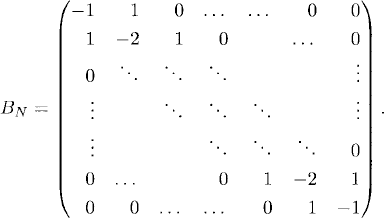
This matrix has a zero eigenvalue that corresponds to the constant solution (the correct stationary solution of this problem). With minor modifications in the proof of Lemma 10.2, it can now be proved:
Lemma 10.3 The matrix BN is diagonable; its eigenvalues λ are real and lie in the interval −4 ≤ λ ≤ 0.
Exercise 10.3 Prove Lemma 10.3.
To integrate in time, exactly the same comments as those in the Dirichlet case hold here.
10.2.2 Finite-differences algebra
As in many semidiscrete problems, it becomes difficult to analyze whether the system of ODEs is diagonable, we use energy estimates to analyze the stability of semidiscrete problems. The algebra can be presented without any extra effort for complex grid functions.
Some basic identities. Let uj, vj be complex grid functions defined on any uniform grid xj = x0 + hj, h > 0, j ![]()
![]() . The space of such grid functions constitutes a vector space. We introduce notation for the Euclidean inner product and norm in finite-dimensional subspaces of grid functions:
. The space of such grid functions constitutes a vector space. We introduce notation for the Euclidean inner product and norm in finite-dimensional subspaces of grid functions:
(10.35) 
and
(10.36) ![]()
The following identities are a direct consequence of the definitions:
Using these properties we can prove the discrete analog of integration by parts, generally called summation by parts.
Lemma 10.4 Let uj, vj be complex grid functions defined on the grid xj = hj, j ![]()
![]() ; then
; then
(10.40) ![]()
Proof: By the second identity in (10.38) and the first identity in (10.39), we have
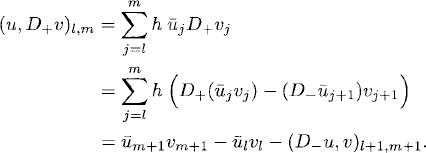
The proof of the second identity is completely analogous.
10.2.3 General parabolic problem
We study here a second-order-accurate semidiscrete approximation of the initial boundary value problem (10.10), (10.11). The semidiscrete system of equations approximating (10.10) is written on the grid (10.32):
The boundary conditions in (10.41) are second-order-accurate approximations of the differential boundary conditions.
As in the homogeneous Neuman case, the values of v0 and vN (at the ghost points) can be expressed in terms of v1 and vN-1, respectively, by means of the boundary conditions. We have
![]()
Choosing h small so that |hr0| ≤ 1 and |hr1| ≤ 1, we have
We want to construct the energy estimate for the semidiscrete energy:
We will need a bound for the grid values vj in terms of the norm of the solution. Clearly, |vj| ≤ h−1||v||1,N-1, but this bound is not useful because it explodes as h → 0. The useful bound involves both the norm of the grid function and the norm of its “grid derivative.” We have
Lemma 10.5 For any grid function and every ε > 0, we have
where C(ε) = 1 + ε−1.
Proof: If fj is constant, the lemma is trivial. Assume that fj is not constant and let l and m be indices such that
![]()
As fj is not constant we can assume, for simplicity, that l < m. By Lemma 10.4,
![]()
that is,

We also need a summation-by-parts formula for the centered derivative D0.
Lemma 10.6
(10.45) ![]()
Exercise 10.4 Prove Lemma 10.6.
We can now estimate the energy (10.43). We have
(10.46) 
Applying Lemmas 10.4 and 10.6 and the boundary conditions, we have
(10.47) 
Using (10.42) first and then (10.44)
(10.48) 
Choosing ε so that −2a + (4a(|r0| + |r1|) + 3|b|)ε ≤ 0, we finally have
(10.49) ![]()
where α = (4a(|r0| + |r1|) + 3|b|)C(ε) + 2|c| is a constant independent of h, the initial data. The energy estimate follows:
(10.50) ![]()
The semidiscrete problem behaves in the same way as the differential case (10.12); the energy can grow with time, but at a rate that is independent of the initial data. One can use explicit Euler, Runge-Kutta, implicit Euler, or the trapezoidal rule (see Exercise 4.2) to integrate in time.
10.2.4 One-way wave equation
We study here a second-order-accurate semidiscrete approximation of the problem (10.13)–(10.15). To this end we again use the grid (10.32) (see Figure 10.1), with two ghost points outside the physical boundaries. The cases a > 0 and a < 0 are completely analogous. Here we present the case a > 0.
We call vj(t) the approximation of u(xj, t). To have a second order accurate semidiscrete approximation, we use D0 in the interior of the domain. Then, we need to complete the system with equations for the values at the ghost points x0 and xN. The value of vN is determined at all times by the boundary condition, which is second order accurate, at x = 1. For v0 we extend the initial data and evolution equation using the first order accurate operator D+ so that we get a stable scheme.1
In matrix form the system ODEs (10.51) becomes
(10.52) ![]()
with

Remark 10.7 The boundary data function g1 (t) becomes the forcing for the system of ODEs. One can easily check using modern computer software, for various dimensions N, that the matrix A is diagonable and its eigenvalues have negative real part and nonzero imaginary part. The theory of Chapter 6 applies.
To prove stability of this scheme, and that the semidiscrete problem behaves as the differential problem, we construct an energy estimate. We use the energy
(10.53) ![]()
Then, using Lemma 10.6 and the boundary conditions, we have
(10.54) 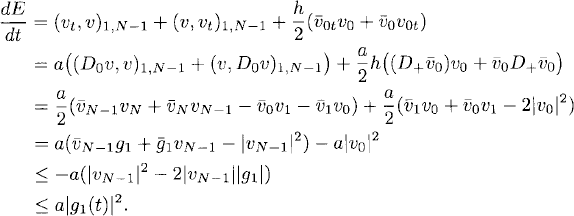
Therefore, integrating, we obtain the energy estimate
(10.55) ![]()
The semidiscrete system of ODEs behaves as the differential equation (see Lemma 10.1). To integrate in time, one needs to use a method that includes the imaginary axis in its stability region (see Remark 10.7). One can use implicit Euler or the trapezoidal rule. However, for hyperbolic equations such as ours, it is generally more efficient to use an explicit multistep method such as Adams-Bashforth.
Exercise 10.5 Consider the problem (10.13)–(10.15) with a = 1, and

![]()
Do you get a value close to 4?
10.2.5 Wave equation
To finish this chapter we present a second-order approximation to solve the initial value problem for the wave equation on a strip. Instead of approximating the problem (10.17), (10.28), we transform the problem as in Section 10.1.3 so that the problem consists in two scalar one-way wave equations coupled by the boundary conditions. Thus, all we need is a second-order semidiscrete approximation of the problem (10.23), (10.24), (10.25). We can apply the second-order approximation studied for the one-way wave equation in Section 10.2.4.
Again the grid is given by (10.32). The semidiscretized system is, calling vji(t) the approximation of wi(xj, t), i = 0, 1,
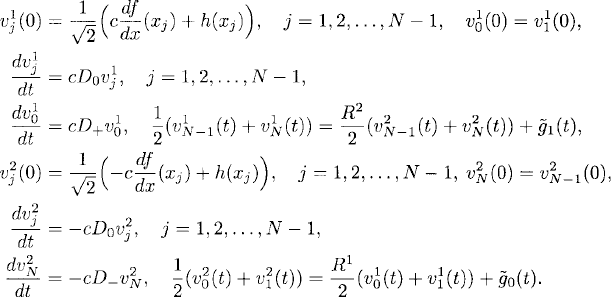
To prove the stability of this approximation, one can use the energy
(10.56) ![]()
For R1 = R2 = 0, this scheme is simply two decoupled one-way equations such as those of Section 10.2.4. Therefore, the scheme is stable. When Ri, i = 0,1, are different from zero, one can get an energy estimate of the form
where K(t) is independent of the initial data.
Exercise 10.6 Prove (10.57).
To integrate in time, one can use the same methods mentioned in Section 10.2.4. Once the problem is solved in this varables, one can get a second-order approximation of the original function φ(x, t) of problem (10.17) since one has second-order approximations for both of its partial derivatives.
1This is equivalent to write a second order accurate evolution for v0 with a linearly extrapolated value of v−1 (i.e., h2D+D−v0 = 0).
